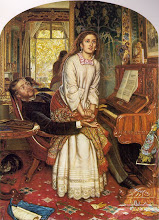(as my old voice teacher from east Texas used to say).
In fact, this humble little recital performance is some of the best singing I've ever heard in my life. It's the radiant Austrian soprano Gundula Janowitz, whose peak years were in the 1960s, singing Mozart's little Lied "Sehnsucht nach dem Frühling" (Longing for Spring). The song has something like folksong status in Germany and Austria, where it's known by its first line, "Komm, lieber Mai" -- and, as you can see in the translation below by Emily Ezust, it's a children's song.
Come, dear May, and make
the trees green again,
and by the brook, let
the little violets bloom for me!
How I would love
to see a violet again -
ah, dear May, how gladly
I would take a walk!
It is true that winter days have
much joy as well:
one can trot in the snow
and play many games in the evening;
build little houses of cards,
play blind-man's-buff and forfeits;
also go tobogganing
in the lovely open countryside.
Ah, if only it would grow milder
and greener out there!
Come, dear may! we children,
we beg you!
O come and bring for us, before anyone else,
lots of violets!
Bring also lots of nightingales
and pretty cuckoos!
Tuesday, December 23, 2008
Now That's Sangin'
Subscribe to:
Post Comments (Atom)











7 comments:
It's very beautiful, but my taste is not finely tuned enough to know why you say it's so *very* good. I don't know that I could tell the difference between this and any pretty competent singer. It's a bit like watching a football game with my brother-in-law who's a coach--I'd like to be able to see everything he's seeing.
What is so good about it, at least to me, is the purity and restraint of her singing. It's not *expansive* singing, in the manner of opera, but it is so nuanced, so beautifully in tune, and so simple. Technically speaking, she is making such a perfect amount of contact with her vocal cords - it's like ice-skating on the edge of the blade. This little song -- obviously an encore -- is a great lesson in great singing.
Janowitz was a wonderful singer of Mozart's operatic soprano roles. There's a fantastic recording of her as Pamina in The Magic Flute under the great Otto Klemperer. Just the purest, most beautiful singing.
Also, she strikes a beautiful balance between an engaging conversational style and the long, lyrical phrases for which she was known in her operatic singing. It's sort of hard to explain why this is so good; it's good in a very restrained, rather than very demonstrative, way. I'll try to think of some things to contrast it with.
FYI, the Japanese subtitles say "hide-and-seek," not "blind-man's bluff." Not sure it matters, though....Merry Christmas!
Ha! Thanks, L! Merry Christmas to you.
"purity and restraint"--yes, that I can relate to. I thought for a long time that I didn't like the classically trained voice, but I eventually realized that it was really only the way it's used in 19th c. opera that I don't like (much).
"...perfect amount of contact with her vocal cords...", on the other hand, is rather mysterious to a non-singer.
I understand what you mean about the use of the voice in 19th-c. opera. Theoretically, a singer should be able to sing 19th-c. opera AND Lieder equally well, but it almost never happens. Operatic singing is expansive, and the best kind of Lieder singing is intimate and conversational. But technically the singer should be doing the same thing. About the cords - there's no pressure or strain in anything she does vocally; the contact of air upon Janowitz's cords is like a bow on a violin string.
Post a Comment